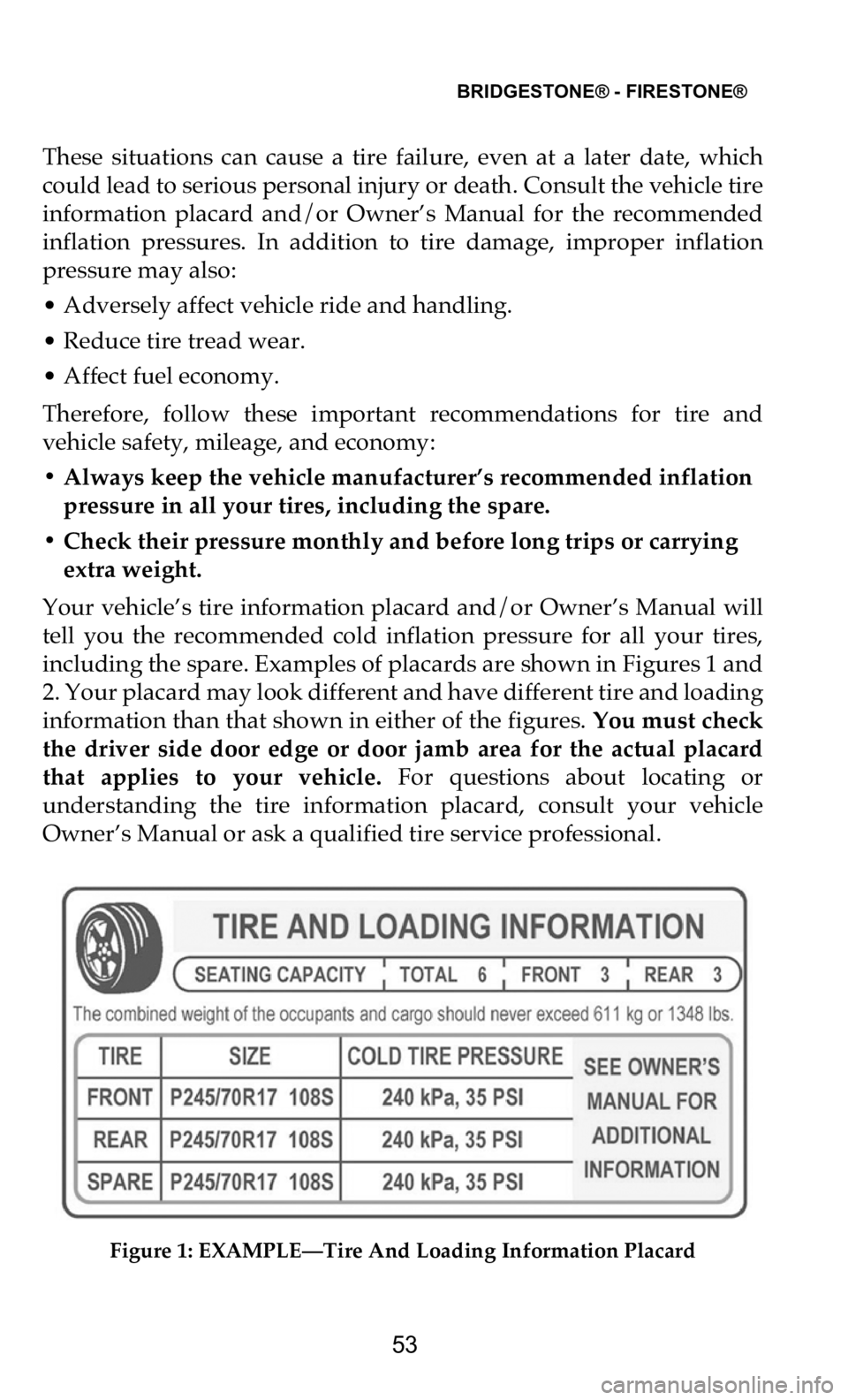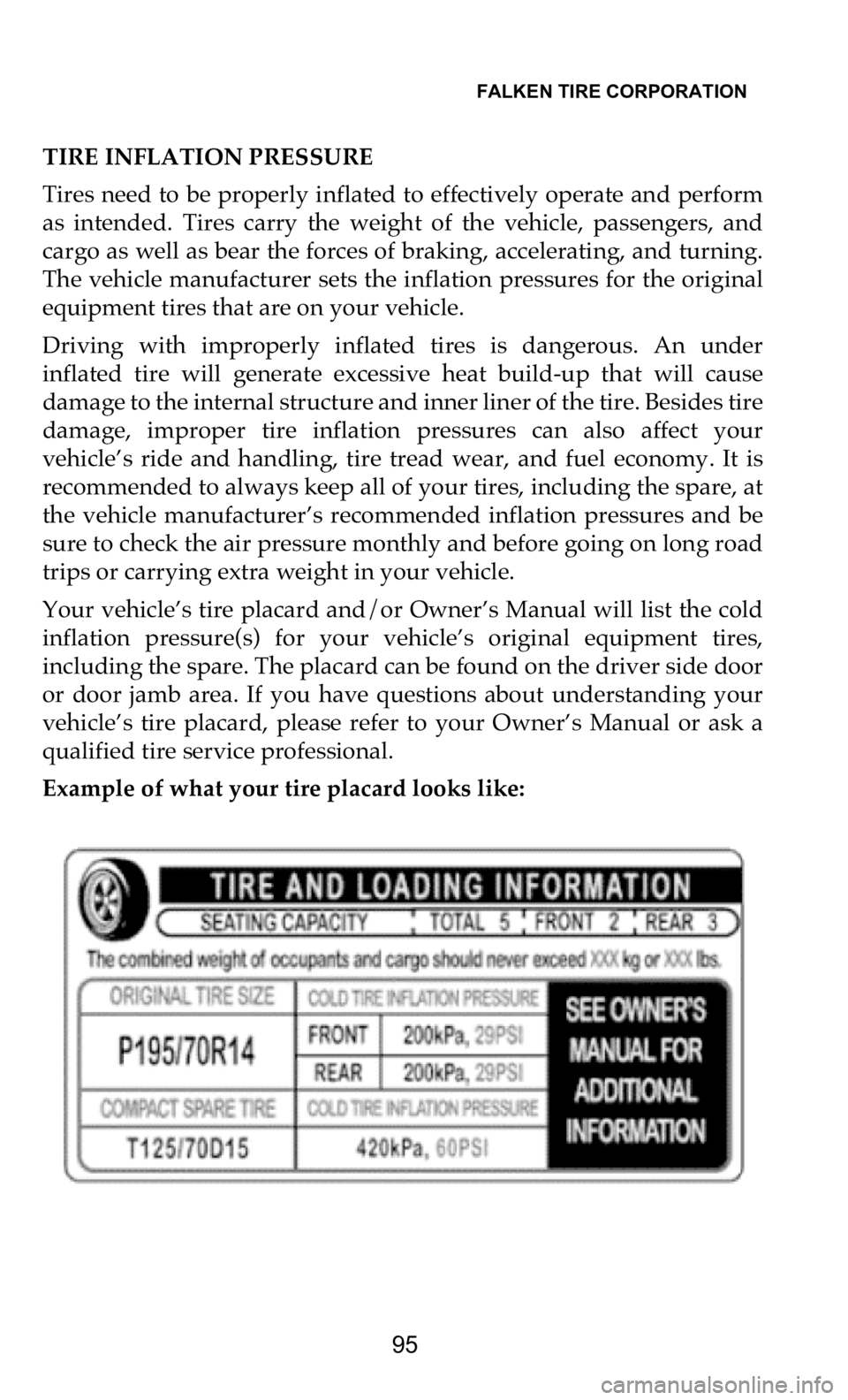fuel DODGE CHALLENGER 2021 Vehicle Warranty
[x] Cancel search | Manufacturer: DODGE, Model Year: 2021, Model line: CHALLENGER, Model: DODGE CHALLENGER 2021Pages: 262, PDF Size: 10.42 MB
Page 12 of 262

TIRES
11
Fuel Economy
Underinflated tires will increase tire rolling resistance resulting in
hi
gher fuel consumption.
Tread Wear
Improper cold tire inflation pressures can cause abnormal wear
pa
tterns and reduced tread life, resulting in the need for earlier tire
replacement.
Ride Comfort And Vehicle Stability
Proper tire inflation contributes to a comfortable ride. Overinflation
pr
oduces a jarring and uncomfortable ride.
Tire Inflation Pressures
The proper cold tire inflation pressure is listed on the driver side
B-
pillar or rear edge of the driver side door.
At least once a month:
• Check and adjust tire pressure with a good quality pocket-type
p
ressure gauge. Do not make a visual judgement when determining
proper inflation. Tires may look properly inflated even when they
are under-inflated.
• Inspect tires for signs of tire wear or visible damage.
I
nflation pressures specified on the placard are always “cold tire
in
flation pressure”. Cold tire inflation pressure is defined as the tire
pressure after the vehicle has not been driven for at least three hours,
or driven less than 1 mile (1.6 km) after sitting for a minimum of three
ho
urs. The cold tire inflation pressure must not exceed the maximum
inflation pressure molded into the tire sidewall.
Check tire pressures more often if subject to a wide range of outdoor
te
mperatures, as tire pressures vary with temperature changes.
Tire pressures change by approximately 1 psi (7 kPa) per 12°F (7°C) of
ai
r temperature change. Keep this in mind when checking tire
pressure inside a garage, especially in the Winter. CAUTION!
After inspecting or adjusting the tire pressure, always reinstall the
va
lve stem cap. This will prevent moisture and dirt from entering
the valve stem, which could damage the valve stem.
Page 31 of 262

BFGOODRICH® TIRES
30
Check cold pressure as soon as possible, preferably within 24 hours.
“Bleeding” air from hot tires could result in under-inflation. Use an
accurate tire gauge to check pressures. Never allow children to
inflate or deflate tires.
TIRE PRESSURE MONITORING SYSTEM (TPMS)
Your vehicle may be equipped with a Tire Pressure Monitoring
Sy
stem (TPMS) that is designed to monitor the pressure of tires
mounted on your vehicle and sends a signal to the driver if a tire
pressure falls below a predetermined level. A TPMS should not
replace monthly manual pressure checks for all four tires and the
spare. We recommend that you manually monitor and check tire
pressure inflation with a pressure gauge.
Your tires should have the recommended pressure listed by your
ve
hicle’s manufacturer. This information can be found in the vehicle
Owner’s Manual and often on a placard located in the vehicle’s door
jamb, inside the fuel hatch, or on the glove compartment door. If you
have a plus size fitment that requires a higher inflation pressure, your
TPMS will require re-calibration to the new inflation pressure. Refer
to your tire dealer/installer of plus size tires for proper inflation
pressure.
We recommend checking air pressure once each month, and before a
lo
ng trip. Whether you have a full-sized or mini-spare, make sure that
it is properly inflated as well. If the TPMS generates improper
monitoring or signals we recommend that you consult your Owner’s
Manual provided with your vehicle and follow up with FCA US LLC.
For Example Only:
Gauge reading of hot tire: .............................................. 32 psi (220 kPa)
If recommended cold inflation pressure is: .................... 30 psi (205 kPa)
Desired gauge reading of hot tire 30 + 4 psi = .............. 34 psi (205 + 30 = 235 kPa)
Therefore: add 2 psi ...................................................... (15 kPa)
Page 54 of 262

BRIDGESTONE® - FIRESTONE®
53
These situations can cause a tire failure, even at a later date, which
could lead to serious personal injury or death. Consult the vehicle tire
information placard and/or Owner’s Manual for the recommended
inflation pressures. In addition to tire damage, improper inflation
pressure may also:
• Adversely affect vehicle ride and handling.
•
Reduce tire tread wear.
•
Affect fuel economy.
T
herefore, follow these important recommendations for tire and
ve
hicle safety, mileage, and economy:
• Always keep the vehicle manufacturer’s recommended inflation p
ressure in all your tires, including the spare.
• Check their pressure monthly and before long trips or carrying e
xtra weight.
Your vehicle’s tire information placard and/or Owner’s Manual will
te
ll you the recommended cold inflation pressure for all your tires,
including the spare. Examples of placards are shown in Figures 1 and
2. Your placard may look different and have different tire and loading
information than that shown in either of the figures. You must check
the driver side door edge or door jamb area for the actual placard
that applies to your vehicle. For questions about locating or
understanding the tire information placard, consult your vehicle
Owner’s Manual or ask a qualified tire service professional.
Figure 1: EXAMPLE—Tire And Loading Information Placard
Page 95 of 262

FALKEN TIRE CORPORATION
94
FALKEN TIRE CORPORATION
FALKEN
MADE BY SUMITOMO RUBBER INDUSTRIES
Congratulations!
Your new vehicle is fitted with high performance and high quality
Fa
lken tires.
In order to guarantee that you receive the best performance and
qu
ality from your new Falken tires, we recommend that you read and
follow all of the maintenance and safety tips provided in this
document. We also suggest that you have your Falken tires
periodically inspected and maintained by a qualified tire service
professional.
A) TIRE CARE AND RECOMMENDATIONS
PROPER INFLATION AND FUEL ECONOMY
Ensure maximum performance and a long life from your tires by
ch
ecking the air pressures at least once a month and set them to the
vehicle manufacturer’s recommended pressure(s) listed on the
vehicle’s tire placard or in your Owner’s Manual. Always check and
adjust your air pressure when your tires are cold, preferably first thing
in the morning before driving. Never release air pressure from tires
when they are hot. Wait until the tires cool down and recheck, adding
air or releasing as required. Falken endorses the use of nitrogen in
your tires because it helps your tires maintain optimal pressure for
longer periods of time and reduces the amount of moisture inside of
the tire and wheel assembly.
*Some plus size applications may require different air pressure(s)
t h
an what is listed on your vehicle’s placard or Owner’s Manual. In
this case, please consult your tire dealer or Falken Tire for proper
inflation pressure(s).
Page 96 of 262

FALKEN TIRE CORPORATION
95
TIRE INFLATION PRESSURE
Tires need to be properly inflated to effectively operate and perform
as
intended. Tires carry the weight of the vehicle, passengers, and
cargo as well as bear the forces of braking, accelerating, and turning.
The vehicle manufacturer sets the inflation pressures for the original
equipment tires that are on your vehicle.
Driving with improperly inflated tires is dangerous. An under
in
flated tire will generate excessive heat build-up that will cause
damage to the internal structure and inner liner of the tire. Besides tire
damage, improper tire inflation pressures can also affect your
vehicle’s ride and handling, tire tread wear, and fuel economy. It is
recommended to always keep all of your tires, including the spare, at
the vehicle manufacturer’s recommended inflation pressures and be
sure to check the air pressure monthly and before going on long road
trips or carrying extra weight in your vehicle.
Your vehicle’s tire placard and/or Owner’s Manual will list the cold
in
flation pressure(s) for your vehicle’s original equipment tires,
including the spare. The placard can be found on the driver side door
or door jamb area. If you have questions about understanding your
vehicle’s tire placard, please refer to your Owner’s Manual or ask a
qualified tire service professional.
Example of what your tire placard looks like:
Page 126 of 262

GOODYEAR® DUNLOP® TIRES
125
•TIRE SPINNING. On slippery surfaces such as snow, mud, ice, etc.,
do not spin tires in excess of 35 mph (55 km/h), as indicated on the
sp
eedometer.
• EXCESSIVE WHEEL SPINNING.
This can also result in tire disin-
tegration or axle failure.
TIRE CARE AND MAINTENANCE GUIDE
The easiest way to help ensure satisfactory mileage and performance
f r
om your Goodyear® or Dunlop® tires is to give them a simple but
frequent (at least monthly) inspection for proper inflation, even tread
wear and the presence of any damage.
DO MAINTAIN PROPER INFLATION PRESSURE IN YOUR TIRES
Proper inflation pressure is necessary for optimum tire performance,
sa
fety and fuel economy. Check inflation pressures at least once a
month and before long trips. Use an accurate tire pressure gauge.
Always check pressures when the tires are cold (when the vehicle has
been driven less than one mile). If you must check inflation when the
tires are hot, add 4 psi (27 kPa) to the recommended cold inflation
pressure. It is difficult to tell just by looking at radial tires whether
they are underinflated.*
WARNING!
Vehicle handling, traction, ride comfort and other performance
pa
rameters may be significantly affected by a change in tire size
or type. Before replacing tires, always consult and follow the
vehicle owner’s manual because some vehicle manufacturers
prohibit changing tire size. When selecting tires that are different
from the original equipment size make certain:
1. The tires have adequate load-carrying capacity based on the
v
ehicle placard,
2. The tires have sufficient inflation pressure to carry the load and
3
. There is proper clearance with no interference points between
t
he tire and vehicle.
The consumer must be aware to always drive safely and obey all
tr
affic laws. Avoid sudden, sharp turns or aggressive lane
changes. Failure to follow any of these warnings may result in
loss of control of the vehicle, leading to an accident and serious
injury or death.
Page 127 of 262

GOODYEAR® DUNLOP® TIRES
126
Furthermore, when operating a vehicle equipped with radial tires, it
is difficult to notice when a tire has gone flat or nearly flat since the
“feel” of the vehicle does not change significantly.
*Evidence of air loss or repeated underinflation always requires
ex
pert inspection to determine the source of leakage and tire
removal to determine repairability. To avoid injury, NEVER attempt
to reinflate a tire that has been run severely underinflated. Progressive
air loss may result from punctures, cuts, curbing, impacts or partial
bead unseating. Some fitment causes for air loss are (1) incomplete
bead seating, (2) bead tearing caused by a machine tool due to
insufficient lubrication or improper adjustment. Leaking valve core or
rubber valve components should be replaced when problems are
detected and whenever tires are replaced.
Always maintain inflation pressure at the level recommended by
t h
e vehicle manufacturer as shown on the vehicle placard, vehicle
certification label or in the vehicle Owner’s Manual:
Under inflation is the leading cause of tire failure and may result in
se
vere cracking, component separation or “blowout.” It reduces tire
load capacity, allows excessive sidewall flexing and increases rolling
resistance, resulting in heat and mechanical damage. Maintaining
proper inflation pressure is the single most important thing you can
do to promote tire durability and maximize tread life.
Over inflation increases stiffness, which may deteriorate ride and
ge
nerate unwanted vibration. Over inflation also increases the
chances of impact damage.
DON’T OVERLOAD YOUR VEHICLE
Check your vehicle Owner’s Manual to determine the load limits.
Ov
erloading your vehicle places stress on your tires and other critical
vehicle components. Overloading a vehicle can cause poor handling
or increased fuel consumption and may cause tire failure.
Overloading your tires can result in severe cracking, component
separation or “blowout.”
Never fit your vehicle with new tires that have less load capacity than
sh
own on the vehicle tire placard and remember that optimum rim
width is important for proper tire load distribution and function. The
maximum load capacity stamped on the sidewalls of P-Metric &
European Metric tires is reduced by 10% when used on a light truck,
utility vehicle or trailer. Never fit P-Metric or European Metric tires to
light trucks that specify LT-type replacement tires.
Page 129 of 262

GOODYEAR® DUNLOP® TIRES
128
THE CONVENIENCE (TEMPORARY) SPARE
The Convenience (Temporary) Spare is designed, built and tested to
th
e high engineering standards set by North America’s leading car
manufacturers and to Goodyear’s own high standards of quality
control. It is designed to take up a minimum of storage space and, at
the same time, fulfill the function of a spare tire when needed. The
spare is kept in its storage space, fully inflated at 60 psi. To be sure it
is always ready for use, the air pressure should be checked on a
regular basis.
The Convenience (Temporary) Spare can be used in combination with
th
e original tires on your vehicle. You can expect a tire tread life of up
to 3,000 miles (4,800 kilometers), depending on road conditions and
yo
ur driving habits. To conserve tire tread life, return the spare to the
storage area as soon as it is convenient to have the standard tire
repaired or replaced.
The Convenience (Temporary) Spare weighs less than a standard tire
so
it’s easier to handle. It also helps reduce the total car weight, which
contributes to fuel economy. The wheels used with the Convenience
(Temporary) Spare are specifically designed for use with high
pressure spares and should never be used with any other type tire.
DO NOT ATTEMPT TO MOUNT YOUR OWN TIRES
Serious injury or death may result from explosion of tire/rim
as
sembly due to improper mounting procedures. Follow tire
manufacturer’s instructions and match tire diameter to rim diameter.
Mount light truck radials on rims approved for radial service. Do not
apply bead sealer. This can inhibit bead seating. Lubricate beads and
tire rim (including tube or flap) contact surfaces. Lock assembly on
mounting machine or place in safety cage. STAND BACK and never
exceed 40 psi to seat beads. Never use a volatile substance or a rubber
“donut” (also known as a bead expander or “O-Ring”) to aid bead
seating. Only specially trained persons should mount tires.
DO NOT MIX TIRES OF DIFFERENT SIZES AND TYPES ON THE
SA
ME AXLE
For optimum handling and control, Goodyear® recommends fitment
of
four tires of the same type and size unless otherwise specified by the
vehicle manufacturer.
Page 168 of 262

MICHELIN®
167
instructions for checking pressures when tires are hot. When tires
have cooled, check air pressure again. If any tire has lost more than
5 PSI from the previous pressure check, have the tire inspected at
once by an authorized PAX® System Retailer for PAX® tires or a
participating Michelin® tire retailer or representative of your
vehicle manufacturer if your vehicle Owner’s Manual so advises.
Failure to do so may cause irreparable damage to the tire and result
in sudden tire destruction and personal injury.
TIRE PRESSURE MONITORING SYSTEMS (TPMS):
Your vehicle may be equipped with a Tire Pressure Monitoring
Sy
stem (TPMS) that is designed to monitor the pressure of tires
mounted on your vehicle and sends a signal to the driver if a tire
pressure falls below a predetermined level. A TPMS should not
replace monthly manual pressure checks for all four tires and the
spare. We recommend that you manually monitor and check tire
pressure inflation with a pressure gauge. Your tires should have the
recommended pressure listed by your vehicle’s manufacturer. This
information can be found in the vehicle Owner’s Manual and often on
a placard located in the vehicle’s door jamb, inside the fuel hatch, or
on the glove compartment door. If you have a plus size fitment that
requires a higher inflation pressure, your tire pressure monitoring
system will require re-calibration to new inflation pressure. Refer to
your tire dealer/installer of plus size tires for proper inflation
pressure.
We recommend checking air pressure once each month, and before a
l o
ng trip. Whether you have a full-sized or mini-spare, make sure that
it is properly inflated as well. If the TPMS generates improper
monitoring or signals we recommend that you consult your Owner’s
Manual provided with your vehicle and follow-up with your vehicle’s
manufacturer.
TIRE SPINNING
Do not spin wheels in excess of 35 mph (55 km/h) as indicated on the
sp
eedometer. Excessive speed in a free-running, unloaded tire can
cause it to “explode” from centrifugal force. The energy released by
such an explosion is sufficient to cause serious physical injury or
death. Never allow anyone to stand near or behind the spinning tire.
When in mud, sand, snow, ice or other slippery conditions, do not
en
gage in excessive wheel spin. Accelerating the motor excessively,
particularly with automatic transmission vehicles, may cause a drive